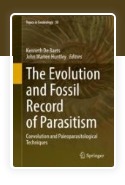“The fossil record of parasitic helminths is often stated to be severely limited. Many studies have therefore used host constraints to constrain molecular divergence time estimates of helminths. Here we review direct fossil evidence for several of these parasitic lineages belong to various phyla (Acanthocephala, Annelida, Arthropoda, Nematoda, Nematomorpha, Platyhelminthes). Our compilation shows that the fossil record of soft-bodied helminths is patchy, but more diverse than commonly assumed. The fossil record provides evidence that ectoparasitic helminths (e.g., worm-like pentastomid arthropods) have been around since the early Paleozoic, while endoparasitic helminths (cestodes, nematodes) arose at least during, or possibly even before the late Paleozoic. Nematode lineages parasitizing terrestrial plant and animal hosts have been in existence at least since the Devonian and Triassic, respectively. All major phyla (Acanthocephala, Annelida, Platyhelminthes, Nematoda, Nematomorpha) had evolved endoparasitic lineages at least since the Mesozoic. Interestingly, although parasitism is considered derived within Metazoa, the oldest evidence for Nematoda and Platyhelminthes includes body fossils of parasitic representatives. Furthermore, the oldest fossil evidence of these parasitic lineages often falls within molecular divergence times based on host co-evolution suggesting the fossil record of helminths themselves might be just as good or at least complementary (and less circular in justification) to calibration based on host associations. Data also provide evidence for obvious host switches or extinctions, which cautions against models of pure co-divergence where use of host calibrations to constrain divergence time estimates may be considered.” Read more

